![]()
![]()
![]()
Use LEFT and RIGHT arrow keys to navigate between flashcards;
Use UP and DOWN arrow keys to flip the card;
H to show hint;
A reads text to speech;
30 Cards in this Set
- Front
- Back
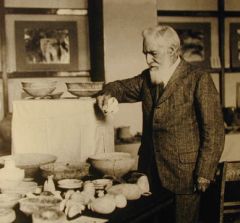
|
Flinders Petrie 1853-1942 Pioneer of systematic methodology in archaeology Relative dating systems |
|
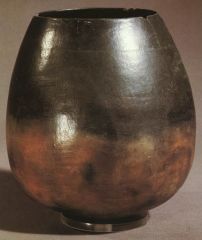
|
Badarian Pottery Black Top Red Wear Pre-Dynastic Egypt |
|
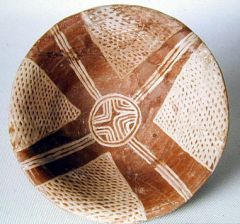
|
White Crossed Lined Pottery Naqada I |
|

|
Naqada II Red on Buff Ceramics Decorated with figurines, weapons, boats Shows development |
|

|
Gebel el Arak Knife Handle Naqada II (3450) Man with hat holding two lions at bay Important: Shows first fight of man against man; foreign influences.
|
|

|
Hierakonpolis Naqada II First painted tomb in subterranean chamber
Key elements of royal iconography: smiting scene, master of animal scene |
|
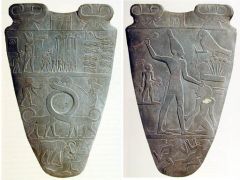
|
Narmeer Palet Photodynamic Period
First artifact showing crowns of upper and lower Egypt = unification of Egyptian state. King Narmeer in Smiting Pose. Victory scene. Development: Specialized craft, tools, artistry Conventions of future art: Scale, Profile, Register Lines 31st Century. |
|
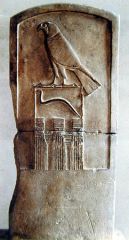
|
Ivory Comb Saraekh Horace Falcoln on top of serpent inside palace facade. King is placed inside walls to show protective nature of Kingship Falcoln is symbol of king Found in tomb of Djet at Abydos. D1. 3200 BC. |
|
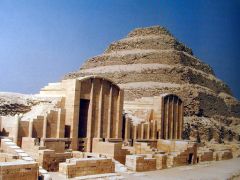
|
Djoser's Step Pyramid Complex 3rd Dynasty Saqquara Imhotep desgigned 14 gates; only 1 work
|
|
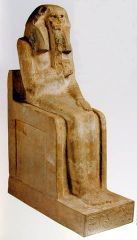
|
Djoser Ser Dab Statue Wearing clothes for Heb Sed Ritual 3rd Dynasty Earliest statue of Egyptian ruler Wearing wig Found in chapel (ser dab)
|
|

|
Djoser Heb Sed Ritual Blue Fiance Tile Jubilee Victorious depiction of king running Shows youth and vigor Plant symbol on right indicates years needed to justify = 30 |
|

|
Metjen Saqqara 4th Dynasty
|
|
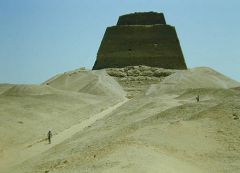
|
Snefru Pyramid at Meidum 4th Dynasty
|
|

|
Meidum Geese Example of detailed representation; artistic skill 4th Dynasty |
|

|
Rahotep and Nofret 4th Dynasty Meidum Proportionate representations; colors; details (hair)
|
|
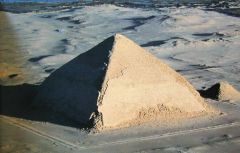
|
Bent Pyramid 4th Dynasty, King Snefru Dashur
Changes angle half way up Causes: Poor foundation, pressure on blocks 2 Enterances
|
|

|
Red Pyramid 4th Dynasty, King Senfru Dashur
1st complete complex: -Pyramid and subidiary pyramid -Mortuary Temple -Causeway -Valley Temple
|
|

|
Hetep-Heres Chair 4th Dynasty
|
|

|
King Khufu Abydos, 4th Dynasty Miniture statue of great builder of Giza Wearing crown of lower Ggypt, Holds flail as symbol of power |
|

|
Boat of King Khufu Giza, 4th Dynasty 5 Boat pits to transport King in afterlife
|
|
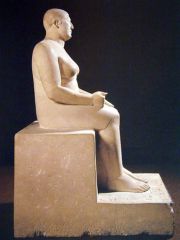
|
Hemiunu 4th Dynasty, Giza Architect of Giza Oversized statue showing fat = prosperous
|
|

|
Wepemnefret 4th Dynasty, Giza
Funeary scene seated in front of loaves of bread Highly detailed (refrences types of linen) |
|
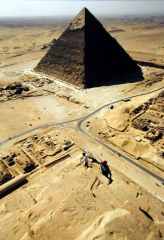
|
Khafre Pyramid 4th Dynasty, Giza Smaller but on higher ground than Khufu Main Features from now on: Entrance Hall, Open Court, Five Statue Niches, Magazines, Sanctuary
|
|

|
Khafre Giza, 4th Dynasty Quintisential powerful pose Perfect musculature, idealized form |
|

|
Bust of Ankh-haf 4th Dynasty, Giza
True Representation: Bags under eyes, receeding hairline.
|
|

|
Reserve Head 4th Dynasty, Giza Found in disturbed contexts, just heads Likeness (unusual)
|
|

|
Menkure Pair Statue 4th Dynasty Masterpiece
|
|

|
Tomb of Unas Pyramid Texts Saqqara 5th Dynasty |
|

|
Meruka Dynasty Six Saqqara
Vizier to Teti Over life size statue In false door niche at west facing east |
|

|
James Henry Breasted and George Reisner Egyptian Archeologists and leaders Breasted - Chicago Reisner - Harvard |

